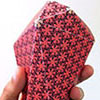 |
AntibodyPaper ModelA paper folding activity that explores the structure of an antibody |
 |
Creating Paper Models of Protein DomainsPaper ModelDownload printable alpha helices and beta strand templates for hands-on exploration of many protein folding domains. |
 |
DNAPaper ModelAtomic structures reveal how the iconic double helix encodes genomic information |
Dengue VirusPaper ModelAtomic structures of dengue virus are giving new hope for creation of a vaccine |
|
 |
Green and Red Fluorescent ProteinsPaper ModelA tiny fluorescent protein from jellyfish has revolutionized cell biology |
G Protein-Coupled Receptor (GPCR)Paper ModelGPCRs are a large family of membrane-embedded receptors, with structural features that have been preserved through the course of evolution. This model represents the shared structural features of all GPCRs. With the extracellular N-terminus, the protein chain folds to form a bundle of seven transmembrane alpha helices connected by 3 intracellular and 3 extracellular loops with the C-terminus reaching inside the cell. |
|
 |
HIV CapsidPaper ModelAt the center of HIV, an unusual cone-shaped capsid protects the viral genome and delivers it into infected cells |
 |
Human Papillomavirus (HPV)Paper ModelThe capsid protein of papillomavirus is used in vaccines that prevent cervical cancer. |
 |
InsulinPaper ModelLearn about insulin, a peptide hormone that plays a critical role in our ability to use glucose from the food that we eat |
 |
Paper Nucleic Acid Models for Hands-on EducationPaper ModelDownload templates for a set of paper models that can be cut from paper or card stock and used for demonstrations of the fundamentals of DNA structure, DNA replication, and RNA translation. |
 |
Quasisymmetry in Icosahedral VirusesActivity PageBuild 3D paper models of several viruses to explore how quasisymmetry builds capsids with different sizes. |
tRNAPaper ModelTransfer RNA translates the language of the genome into the language of proteins |
|
 |
Zika Virus with and without antibodiesPaper ModelAtomic-level structures of Zika virus will help researchers better understand how the virus enters human cells and sets the stage for vaccine discovery and drug development. |
About PDB-101
Researchers around the globe make 3D structures freely available from the Protein Data Bank (PDB) archive. PDB-101 training materials help graduate students, postdoctoral scholars, and researchers use PDB data and RCSB PDB tools. Outreach content demonstrate how PDB data impact fundamental biology, biomedicine, bioengineering/biotechnology, and energy sciences in 3D by a multidisciplinary user community. Education Materials provide lessons and activities for teaching and learning.
PDB-101 is developed by the RCSB PDB.
RCSB PDB Core Operations are funded by the U.S. National Science Foundation (DBI-2321666), the US Department of Energy (DE-SC0019749), and the National Cancer Institute, National Institute of Allergy and Infectious Diseases, and National Institute of General Medical Sciences of the National Institutes of Health under grant R01GM157729.